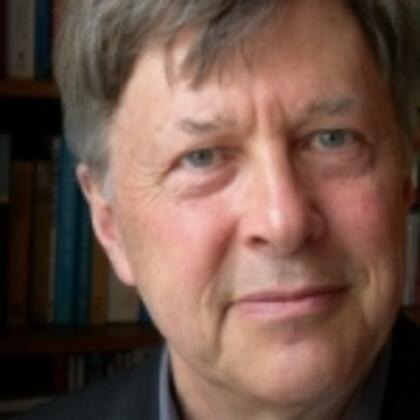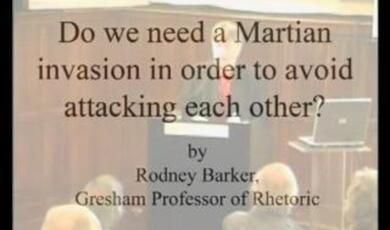Explanations of enmity: pessimists, optimists and sceptics
Share
- Details
- Transcript
- Audio
- Downloads
- Extra Reading
Theories, explanations and justifications of enmity, from Adam Ferguson in the Eighteenth Century to Carl Schmitt in the Twentieth.
Download Transcript
EXPLANATIONS OF ENMITY:
PESSIMISTS, OPTIMISTS AND SCEPTICS
Professor Rodney Barker
*1 PICTURE
*2 PICTURE
1. Lion and lamb: The wolf also shall dwell with the lamb, and the leopard shall lie down with the kid; and the calf and the young lion and the fatling together; and a little child shall lead them. (Isaiah 11:6)
It might seem obvious that peaceful and enmity free life would be a universal ideal. 'Peace' is a normal, taken for granted aspiration in both secular and religious aspirations
But not so. There are a number of thinkers who have presented enmity and the existence, real or imagined, of enemies, as either an inevitable, or an essential, or a positively desirable, feature of human life.
Remember The Third Man and the cuckoo clock:
'In Italy for 30 years under the Borgias they had warfare, terror, murder, bloodshed - but they produced Michelangelo, Leonardo da Vinci, and the Renaissance. In Switzerland they had 500 years of democracy and peace, and what did that produce? The cuckoo clock.'
So peace may be universally desired, but the advocates of peace don't have a monopoly. There are other voices too.
2. Ferguson. Scotland, or more precisely Edinburgh, in the Eighteenth Century.
1767, Essay on Civil Society
*3 PICTURE
20 years after Culloden Jacobotism had finally faded away, and with it the threat of dynastic and religious revolution and turmoil. But peacefulness a danger, not a reassurance Far from celebrating peacefulness, Ferguson warned of its dangers, and of the advantages of enmity.
They were of two kinds and, since Ferguson was not a systematic thinker, there is a certain tension between those two advantages
The first advantage is in cultural and social dynamism:
'Greece, divided into many little states, and agitated, beyond any spot on the globe, by domestic contentions and foreign wars, set the example in every species of literature. The fire was communicated to Rome; not when the state ceased to be warlike, and had discontinued her political agitations, but when she mixed the love of refinement and of pleasure with her national pursuits, and indulged an inclination to study in the midst of ferments, occasioned by the wars and pretensions of opposite factions. It was revived in modern Europe among the turbulent states of Italy, and spread to the North, together with the spirit which shook the fabric of the Gothic policy: it rose while men were divided into parties, under civil or religious denominations, and when they were at variance on subjects held the most important and sacred.'
Ferguson is arguing that danger and division are a stimulant, perhaps a necessary stimulant, to intellectual and artistic vigour and creativity
But it also made solidarity possible, and that is the second, and slightly inconsistent advantage
'common danger' made possible a cohesion within nations that could not otherwise be achieved, by 'uniting their members more firmly together, and by preventing the secessions and actual separations in which their civil discord might otherwise terminate.'
'it is vain to expect that we can give to the multitude of a people a sense of union among themselves, without admitting hostility to those who oppose them'
So there is a tension, between arguing on the one hand for the value of internal competition and even discord as providing the conditions for cultural and social dynamism, and arguing on the other for the value of external threats or enemies in cultivating social, internal unity.
The image is a bit like the internal combustion engine: powered by explosions within, but dependent on those explosions being confined in a rigid metal casing. So internal dissension is the explosion, and external threats the casing.
Another way of presenting this solution, which is not developed by Ferguson, lies in thinking not of a simple distinction between friends on the one hand and enemies on the other, or between either peace and unity, or discord and conflict, but rather thinking in terms of a scale, from competition at one end to demonisation at the other, with antagonism and enmity somewhere in between:
*4 PICTURE
The two positions on the left give the degree of competition, even discord, which Ferguson considers productive of social and cultural dynamism.
The two positions on the right would be destructive of social or national unity - that was what Jacobitism had been - but between nations as against within them, can have exactly the opposite effect.
If this distinction is made, the tension within Ferguson's account can be resolved, even if it involves improving his argument beyond what he actually wrote himself
3. Simmel
My next candidate also exhibits this tension, between internal dynamism on the one hand, and the desirability of national unity on the other.
*5 PICTURE
The late nineteenth, early twentieth century German sociologist Georg Simmel, wrote a short book called, simply, Conflict.
Intellectually eminent, professionally marginalised
Simmel's work illustrates this push and pull between the value of discord within societies, but also the benefit of conflict between societies in creating unity and cohesion within them.
His argument shares some of the elements of the 'desirability' account of writers such as Ferguson. He writes that
'An absolutely centripetal and harmonious group, a pure "unification", not only is empirically unreal, it could show no life process. The society of saints which Dante sees in the Rose of Paradise may be like such a group, but it is without any change and development;
*6 PICTURE
whereas the holy assembly of Church Fathers in Raphael's Disputa shows if not actual conflict, at least a considerable differentiation of moods and directions of thought, whence flow all the vitality and the really organic structure of that group...
*7 PICTURE
But here, as with Ferguson, there is a tension between seeing a value in internal discord for promoting cultural vigour, and a value in external enemies for promoting social and national cohesion.
But his stress is far more heavily on national unity, and whilst he mentions cultural dynamism, it is the unity of nations which principally concerns him.
This can partly be explained by where and when he was writing, at the end of a century which had seen the upsurge of the politics of nationalism and, in the case of his own Germany, nationalism as the justifying and powering ideology of a new unified and enlarged state.
'Essentially, France owes the consciousness of its national unity only to its fight against the English, and only Moorish war made the Spanish regions into one people.'
'The United States needed the War of Independence; Switzerland, the fight against Austria; the Netherlands, rebellion against Spain; the Achaean League, the struggle against Macedonia; the founding of the new German Empire furnishes a parallel to all these instances.'
But now he goes rather further than Ferguson, and whilst not saying anything that Ferguson might have disputed, allows for a rather more active role in ensuring enmity than Ferguson envisaged:
'it may even be a piece of political wisdom to see to it that there be some enemies in order for the unity of the members to remain effective and for the group to remain conscious of this unity as its vital interest.'
'It is expedient to hate the adversary with whom one fights (for any reason), just as it is expedient to love a person whom one is tied to and has to get along with.'
The element of governmental collusion or conspiracy is thereby added to the arguments of Ferguson 150 years earlier. Ferguson assumed there would be real enemies, and that any perception of them would simply be a reflection of this real nature. He did not imagine they would or could be called into existence or, as we have come to say, 'sexed up'
Simmel at least raises the possibility that Enemies do not have to be real, and there will be benefits, if necessary, in inventing them, or that enmity can be conjured up because of its usefulness.
4. Schmitt
Simmel died in the year the First World War ended. My third contributor lived and wrote in the aftermath of that war, and of the consequences of that aftermath for his native Germany.
Like Simmel, his work was neglected for a rather long time, though for very different reasons.
*8 PICTURE
We like to think that we take thinkers seriously on their merits, whatever we think of their conclusions or of the intellectual or political company they keep.
But it's never as simple as that.
For much of the twentieth century, for instance, Marx was read, thought about, and used principally by Marxists, and avoided by those who thought of themselves as occupying a different political camp.
The intellectual divisions, in other words, reflected the ideological and international divisions. The world was divided, politically, between communist east and capitalist west, and the Cold War gave military and diplomatic expression to this division.
A further division, which cut across this one at least up until the end of the Second World War, was between totalitarianism and democracy
These divisions provided a political map which enabled people to locate themselves, and the possible positions were pretty firmly set down.
And the problem with Schmitt was that he allied himself clearly if opportunistically with the Nazi regime, was seen as a theorist of fascism, and was therefore, as far as liberals, democrats, or anyone on the left was concerned, entirely beyond the pale.
There was a little interest in him before 1989, during which time he would not have been admitted to polite conversation however interesting his arguments, but a profusion of writing thereafter.1989, the end of the Cold War, the collapse of Eastern European communist regimes, changed all that. The old map was rolled up, and instead of the set ideological menu, there was a kind of ideological pick and mix, so that it was possible, or easier, to draw on all or any thinkers, without being seen as joining a camp or a cause
The intellectuals maps which had consigned him to the forbidden zone has been thrown away, and there was no authoritative alternative, though lots of claimants- plenty of rough guides, no ordnance survey
The attention paid to Schmitt is an indication of how far we have come since the end of the 'short twentieth century',
Like Hobbes, Carl Schmitt was writing in uncertainty and political flux and instability. Enmity divided the state and made government impossible. The German nation had been defeated in the First World War and subjected to a peace which nationalists saw as humiliating and punitive
The early years after the war's end were marked by revolution and counter-revolution, a limited civil war with armed groups of both right and left fighting in the streets.
Schmitt's historical location in a Germany which appeared both isolated and threatened provides a context to his stockade account of the role of enmity in politics.
His own place in this was that of a legal and political theorist for whom a mixture of desire for strong unifying government, a dislike of liberalism, and a degree of opportunism, led him to ally himself actively with the Nazi movement and regime.
His method of argument was very different from that of either Ferguson or Simmel. Whilst they attempted to summarise the varieties of actual politics, Schmitt started at the other end, with an ideal or abstract definition of 'what politics is', and then, when he came across instances which didn't fit, simply said that they couldn't be called politics.
His most famous statement is:
'The specific political distinction to which political actions and motives can be reduced is that between friend and enemy.'
Well, theorists like neatness, but in order to get any use out of Schmitt, we need to translate his rather special use of words.
What he seems to be saying is that in the last resort states call on their subjects to fight and risk their lives in combat with an enemy, and that this is what distinguishes states (which he calls 'the political') from other kinds of association.
If religious or economic or social groups successfully make that same demand on their members then they have, in his terms, become 'political' bodies.
It makes more sense to say that what they are doing is challenging government, or engaging in civil war.
So Schmitt's use of the idea of enmity is all about the unity of states in conflict with other states, and has nothing to say about the kind of internal disputes and competition which both Simmel and Ferguson describe. If anything, Schmitt is rather alarmed by the possibility of any such thing.
The enemy is 'existentially something different and alien', and, in the purest form, 'intends to negate his opponent's way of life and therefore must be repulsed or fought in order to preserve one's own form of existence.'
'An enemy exists only when, at least potentially, one fighting collectivity of people confronts a similar collectivity.'
What is striking about all of this is that whilst Schmitt sees such enmity as creating national unity, that nation has no identity apart from the fact that it opposes the same enemy
The problem with this negative identity is that it avoids saying what you stand for, and expends all its energy on the depiction of the enemy, who swiftly becomes rather more interesting
*9 PICTURE
*10 PICTURE
But whereas Ferguson had talked of the creative effects of enmity and external threats, and internal discord, simply as possiblities
And Simmel had discussed the possibility of the cultivation of enmity
Schmitt seemed to allow no variations, no qualifications, and very little room for human agency. Whereas the other two were describing possibilities, advantages and disadvantages, Schmitt seemed to be saying that this is what the world was like and that was that.
5. Murray Edelman and others.
My fourth contributor, whilst not writing after the end of the 'short twentieth century' after 1989, is writing after the end of the Second World War and the experience of the devastating ambitions of both Nazism and Communism. These events drew attention to both the attractions, and dangers, of simple general theories and the desirability of tentative, possibility approaches
For Murray Edelman, an American sociologist writing in 1988, just before the end of the Cold War, there is a range from competition to enmity, and politics takes place at one end, enmity at the other
'Enemies are distinct from opponents or adversaries. Enemies are described in a world where what is important is inherent nature, adversaries or opponents in a world where salience is given to rules or conventions of a common competition or game.'
Edelman, even more than Simmel, recognises that enemies may be made and that, if they already exist, there can be good reasons for maintaining them:
'To stop exaggerating the enemy's dangerous potentialities or to employ physical force to eliminate him would signal change; but to continue verbal assaults and indecisive physical movements that have long taken place is to signal that all will remain as it has been: that the dramaturgy of enmity is consolidating public support for regimes, for causes, and for inequalities.'
6. Hegel
The four thinkers I've discussed up to now saw two benefits from conflict and enmity:
Dynamism at home
Unity abroad
But there is a further, related consequence of enmity and opposition which has been described by my final contributor:
Situations of conflict and opposition can be a means of broadening, realising, or expressing identity.
But they are not the only way, or a necessary way:
*11 PICTURE
G. W. F. Hegel was writing at the very start of the nineteenth century, and the context in which he was working was therefore one of Napoleonic wars and European revolution. It was the age of collective action and the formation of popular nation states.
Hegel provides answer to the question why do individuals do anything as irrational as go to war.
Collective identity in war:
'in war the power of association of all with the whole is in evidence'. In war, people become themselves by becoming more than they previously were.
The collective identity is so strong that individual physical survival seems subordinate to it
But this greater identity, though it arises in conflict, does so not because of any contrast or enmity with another army, but because of the realisation achieved in the willingness to face death. Enmity, in fact, may not occur at all, and is an almost incidental feature of warfare: 'Modern wars are therefore humanely waged, and person is not set against person in hatred. At most, personal enmities appear in the vanguard, but in the main body of the army hostility is something vague and gives place to each side's respect for the duty of the other.'
Master/slave. The value placed on identity over mere physical survival
In other words more important than enemies, is others whom you respect and who recognise and respect you
Hegel thus addresses the crucial question of the nature and conditions of human solidarity. How do people collaborate in a way that the 'all' takes precedence over the 'one' and that, even more strongly, the 'one' cannot be conceived except in relation to the 'all'?
*12 PICTURE
Crucially, although conflict can play a role, it is not a necessary one
7. For and Against Enmity
First) So in order to get the best use out of these thinkers, we need an eclectic synthesis, of the kind which Edleman comes closest to providing
*13 PICTURE
Apart perhaps from Schmitt, none of these thinkers or writers insist that this or that is how things must be, will always be, or only can be. They are all arguing about possibilities and therefore about choices.
What a cautious and eclectic account involves is a recognition that nothing is determined, and all we can point to is a range of the possibilities that (up until now, so far) we have come across
Beware of laws and predictions, since people can always choose, and different responses are possible to the same circumstances, or apparently similar circumstances can be quite differently perceived
Even though they operate in in circumstances not of their own choosing, men still make their own history.
Second) It's important to remember that real people are not philosophers or social scientists, so don't observe these distinctions
Third) A man cannot be too careful in his choice of enemies. But nor can he be too careful in distinguishing between enemies and competitors, or in assessing the need or desirability of enemies at all.
©Professor Rodney Barker, Gresham College, 4 February 2008
This event was on Mon, 04 Feb 2008
Support Gresham
Gresham College has offered an outstanding education to the public free of charge for over 400 years. Today, Gresham plays an important role in fostering a love of learning and a greater understanding of ourselves and the world around us. Your donation will help to widen our reach and to broaden our audience, allowing more people to benefit from a high-quality education from some of the brightest minds.


 Login
Login







